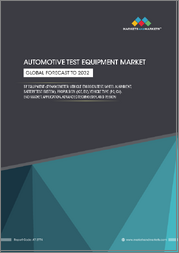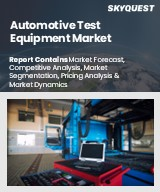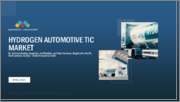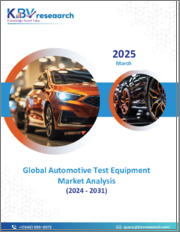
|
시장보고서
상품코드
1622047
자동차 시험 장비 시장 : 장비 유형별, 용도별, 지역별, 범위 및 예측Automotive Test Equipment Market By Type of Equipment, By Application, By Geographic Scope and Forecast |
||||||
자동차 시험 장비 시장 규모와 예측
자동차 시험 장비 시장 규모는 2024년에 34억 3,000만 달러로 평가되며, 2031년에는 45억 8,000만 달러에 달할 것으로 예측되며, 2024-2031년 CAGR은 4.04%로 성장합니다. 자동차 테스트 장비는 자동차 산업에서 자동차 및 그 부품의 성능, 내구성, 안전성 및 효율성을 검사하고 평가하기 위해 사용하는 장비와 기술의 집합체입니다. 이러한 전문 장비에는 진단 툴, 배기가스 테스트, 동력계, 오실로스코프, 엔진 성능, 배기가스 수준, 제동 효율, 서스펜션 역학, 전기 시스템 기능을 평가하는 기타 센서 등이 포함됩니다. 자동차 테스트 장비는 자동차가 규제 기준을 충족하고, 성능을 최적화하고, 결함을 감지하고, 새로운 자동차 기술을 연구하고 개발하는 데 필수적입니다.
자동차 기술 및 규제 기준의 발전이 수요를 촉진함에 따라 자동차 테스트 장비의 미래 전망은 밝습니다. 자동차 제조업체들이 전기자동차와 자율주행차로 혁신을 거듭하면서 첨단 테스트 솔루션에 대한 수요가 증가할 것으로 보입니다. 여기에는 배터리 시스템, 자율주행 기능, 통신 기능, 자동차 안전 시스템을 테스트하는 툴이 포함됩니다. 또한 전 세계에서 엄격한 규제 요건은 정밀한 배기가스 테스트, 연비 및 안전 규정 준수를 요구하고 있습니다.
세계의 자동차 시험장비 시장 역학
세계의 자동차 테스트 장비 시장을 형성하는 주요 시장 역학
주요 시장 성장 촉진요인
기술의 진보 :
전기자동차(EV), 자율주행 시스템, 커넥티드카 등 자동차 기술이 발전함에 따라 첨단 테스트 장비가 필요합니다. 제조업체와 규제 당국은 안전 기준, 성능 기준, 배기가스 기준의 적합성을 검증하기 위해 정밀한 테스트를 요구하고 있으며, 이에 따라 첨단 테스트 장비에 대한 수요가 증가하고 있습니다.
엄격한 규제 기준 :
전 세계에서 자동차 배기가스, 안전 및 효율성을 규제하는 법률이 점점 더 엄격해짐에 따라 자동차 제조업체들은 종합적인 테스트 솔루션에 투자하고 있습니다. 규제 요건을 준수하기 위해서는 정확하고 신뢰할 수 있는 테스트 장비가 필요하며, 이는 시장 성장을 가속하고 있습니다.
자동차 생산량 증가
: 세계 자동차 제조, 특히 아시아태평양 및 라틴아메리카와 같은 성장 국가에서의 지속적인 성장으로 인해 자동차 테스트 장비에 대한 수요가 증가하고 있습니다. 제조업체들은 품질 기준을 유지하고 생산 목표를 달성하기 위해 효율적인 테스트 솔루션을 찾고 있으며, 이는 시장 확대의 원동력이 되고 있습니다.
자동차의 안전과 품질 중시:
안전하고 우수한 품질의 자동차에 대한 소비자의 요구가 높아지면서 자동차 제조업체들은 엄격한 테스트 시스템을 도입하고 있습니다. 여기에는 충돌 안전성, 내구성, 신뢰성, 다양한 조건에서의 성능에 대한 테스트가 포함되며, 최신 테스트 기술의 사용을 장려하고 있습니다.
주요 과제
제품 변동성 복잡성:
자동차 테스트 장비에는 엔진 테스트, 배기가스 테스트, 차량 운동 테스트, 충돌 테스트 등 특정 테스트 용도를 위해 개발된 다양한 제품이 포함됩니다. 따라서 정확성과 효율성을 희생하지 않고 다양한 테스트 요구 사항을 충족하는 적응형 솔루션을 구축하는 것은 어려운 일입니다.
다양한 고객 요구사항
: 자동차 산업 고객에는 OEM(주문자 상표 부착), 독립 정비소, 시험소 등이 있습니다. 각 고객 부문은 시험기의 기능, 신뢰성, 정확성, 비용 효율성 측면에서 특정 요구사항이 있을 수 있습니다. 일관된 세분화를 유지하면서 이러한 다양한 수요를 충족시키는 것이 과제입니다.
비용과 예산의 제약:
자동차 산업에서 비용 요소는 구매 의사결정에 있으며, 중요한 요소로, OEM은 광범위한 테스트 능력을 확보하기 위해 고가의 고급 테스트 장비에 중점을 두는 반면, 소규모 공장에서는 기본적인 규제 기준을 충족하는 비용 효율적인 옵션을 요구할 수 있습니다. 장비의 기능 및 성능과 비용의 균형을 맞추는 것은 어려운 일입니다.
기존 시험 인프라와의 통합:
많은 자동차 OEM과 테스트 시설들은 이미 기존 테스트 장비와 인프라에 많은 투자를 하고 있습니다. 새로운 테스트 장비는 이러한 기존 시스템과 원활하게 상호 작용하여 업무 효율성을 높이고, 다운타임을 줄이며, 기존 데이터 및 절차와의 호환성을 보장할 수 있어야 합니다.
주요 동향 :
전기자동차 및 자율주행차 테스트:
전기자동차(EV)와 자율주행차(AV) 증가에 따라 이들 기술에 특화된 전용 테스트 장비에 대한 수요도 증가하고 있습니다. 여기에는 배터리 테스트 시스템, 충전 인프라 테스트 장비, 시청각 센서 테스트 장비 등이 포함됩니다.
커넥티드카로의 전환 :
커넥티드카 기술의 확장은 V2X(Vehicle-to-Everything) 커넥티비티, 사이버 보안, 차량용 인포테인먼트 시스템을 분석할 수 있는 테스트 장비를 필요로 합니다. 이러한 추세는 하드웨어와 소프트웨어 컴포넌트를 모두 포함하는 통합 테스트 솔루션에 대한 수요를 촉진하고 있습니다.
인더스트리 4.0과 디지털화:
자동차 테스트 장비 업계는 디지털화, 빅데이터 분석, 클라우드 컴퓨팅을 포함한 인더스트리 4.0의 원칙을 채택하여 원격 모니터링, 예지보전, 실시간 데이터 인사이트을 가능하게 하고 있습니다. 이를 통해 운영 효율성을 높이고 다운타임을 최소화할 수 있습니다.
비용 효율성과 유연성 중시:
다양한 차량 모델과 생산 규모에 따라 변화하는 테스트 요구사항에 대응할 수 있는 비용 효율적인 테스트 솔루션에 대한 관심이 높아지고 있습니다. 이러한 수요에 대응하기 위해 모듈식, 확장성이 뛰어난 테스트 플랫폼이 인기를 끌고 있습니다.
세계의 자동차 시험장비 시장, 지역별 분석
세계의 자동차 테스트 장비 시장에 대한 보다 상세한 지역별 분석을 소개합니다. :
북미:
북미, 특히 미국은 유명한 자동차 제조업체, 연구 기관 및 기술 선구자들이 집중되어 있는 것으로 알려져 있습니다. 이러한 전문성은 IoT, AI, 자동화 등 첨단 기술을 포함한 자동차 테스트 장비의 지속적인 개발을 촉진하고 세계 표준을 자주 정의하며 전 세계 자동차 테스트 방법에 영향을 미치고 있습니다.
미국, 캐나다, 멕시코에는 자동차 OEM 및 Tier 1 공급업체가 존재하므로 연구개발(R&D)에 많은 투자가 이루어지고 있습니다. 이러한 투자는 자동차의 성능, 안전 및 엄격한 규제 기준 준수를 개선하기 위한 것으로, 생산주기 전반에 걸쳐 첨단 테스트 장비에 대한 수요가 높습니다. 북미는 미국 환경보호청(EPA)과 캐나다 교통부(Transport Canada)와 같은 기관이 관리하는 엄격한 규제 프레임워크에 의해 규제를 받고 있습니다.
북미 전역, 특히 미국 디트로이트와 캐나다 온타리오와 같은 자동차의 주요 거점에는 현대적인 테스트 시설과 인프라가 있습니다. 첨단 동력계, 환경 시험실, 시뮬레이션 툴을 갖춘 이 시험 시설들은 북미의 중요한 시험 거점으로서의 입지를 강화하는 동시에 국내 및 해외 자동차 시장에 기여하고 있습니다. 이러한 법규 준수는 자동차 배출가스, 연비 및 종합적인 성능을 정확하게 측정하고 확인할 수 있는 자동차 시험 전문 장비의 사용을 장려하고 있습니다.
북미 구매층은 최신 기능을 갖춘 고품질 자동차를 강력하게 요구하고 있으며, 이를 위해서는 엄격한 테스트 절차가 필요합니다. 전기자동차(EV), 자율주행 시스템, 네트워크 기능 등 자동차 기술의 변화로 인해 신뢰성 및 안전 요구사항을 준수하면서 빠른 개발 주기를 촉진하는 특수 테스트 장비에 대한 수요가 증가하고 있습니다.
북미의 주요 자동차 테스트 장비 제조업체 및 공급업체들은 세계 판매 채널을 구축하고 있습니다. 이러한 네트워크는 북미의 기술력과 브랜드 이름을 활용하여 유럽, 아시아태평양 및 라틴아메리카 시장에 새로운 테스트 솔루션을 수출할 수 있게 해줍니다. 이러한 세계 진출로 북미는 자동차 테스트 장비 시장의 세계 리더로서의 입지를 강화해 나가고 있습니다.
아시아태평양:
아시아태평양은 중국, 일본, 한국, 인도가 주도하는 세계 자동차 제조 강국으로 꼽힙니다. 이 지역의 높은 자동차 생산량으로 인해 자동차의 품질, 안전 및 국제 표준 준수를 보장하기 위한 강력한 테스트 및 검증 시스템이 필요합니다. 이러한 수요는 공급망 전반에 걸쳐 자동차 테스트 장비의 사용을 촉진하고 있습니다.
전기자동차(EV), 자율주행 기술, 커넥티드카 등 아시아태평양 자동차 산업의 혁신은 개발, 검증, 인증을 위한 첨단 테스트 장비를 필요로 합니다. 현지 기업 및 연구기관들은 이러한 개선을 지원하기 위해 최첨단 테스트 솔루션에 투자하고 있으며, 이는 시장 성장의 원동력이 되고 있습니다.
중국과 인도와 같은 국가에서는 자동차 배기가스, 안전 및 성능에 대한 엄격한 규제 요건으로 인해 자동차 테스트 장비의 채택이 증가하고 있습니다. 이러한 요건을 준수하기 위해서는 특수한 테스트 장비와 시스템을 사용해야 하므로 장비 제조업체와 서비스 프로바이더는 이점을 누릴 수 있습니다. 제조 공장, 테스트 시설, 연구센터 등 자동차 인프라에 대한 지속적인 투자는 아시아태평양의 자동차 테스트 장비에 대한 수요를 촉진하고 있습니다. 이러한 투자는 생산 능력을 향상시키고, 품질관리 절차를 강화하며, 첨단 테스트 방법의 개발을 지원합니다.
자동차의 안전, 성능 및 환경 영향에 대한 고객의 인식이 높아지면서 견고한 테스트 기술을 채택하는 동기가 되고 있습니다. 아시아태평양의 자동차 OEM들은 고객의 기대에 부응하고 세계 시장에서 경쟁하기 위해 품질 보증에 중점을 두고 있으며, 이에 따라 신뢰성과 규정 준수를 보장하는 첨단 테스트 장비에 대한 요구가 증가하고 있습니다. 아시아태평양 국가들은 낮은 생산 비용과 기술력을 바탕으로 자동차 수출 시장을 적극적으로 확대하고 있습니다. 이러한 지역 통합으로 인해 다양한 시장에서 표준화된 시험 기술과 시험 장비가 필요하며, 자동차 부품과 자동차의 국경 간 거래가 가능해졌습니다.
현지 자동차 제조업체, 다국적 OEM 및 기술 프로바이더가 협력하면 자동차 테스트 프로세스의 혁신과 정보 전달을 촉진할 수 있습니다. 세계 테스트 장비 회사와의 파트너십은 새로운 기술과 프로세스에 대한 접근성을 향상시켜 시장 성장과 경쟁 강화를 가져옵니다. 아시아태평양 정부는 법률, 보조금 및 보조금을 통해 자동차 R&D, 우수 제조 및 기술에 대한 인센티브를 제공합니다. 이러한 정책은 혁신적인 테스트 장비 인프라에 대한 투자를 촉진하고 업계 관계자들에게 유리한 비즈니스 환경을 제공합니다.
목차
제1장 서론
- 시장의 정의
- 시장 세분화
- 조사 방법
제2장 개요
- 주요 조사 결과
- 시장 개요
- 시장 하이라이트
제3장 시장 개요
- 시장 규모와 성장 가능성
- 시장 동향
- 시장 성장 촉진요인
- 시장 성장 억제요인
- 시장 기회
- Porter's Five Forces 분석
제4장 자동차 시험 장비 시장 : 장비 유형별
- 엔진 동력계
- 섀시 다이나모미터
- 자동차 배출 가스 시험 시스템
- 휠얼라이먼트 테스터
- 연료 분사 펌프 시험기
제5장 자동차 시험 장비 시장 : 용도별
- 차량 진단
- 안전성능시험
- 배기가스 시험
제6장 자동차 시험 장비 시장 : 자동차 유형별
- 승용차
- 상용차
- OHV(Off-highway Vehicle)
제7장 지역별 분석
- 북미
- 미국
- 캐나다
- 멕시코
- 유럽
- 영국
- 독일
- 프랑스
- 이탈리아
- 아시아태평양
- 중국
- 일본
- 인도
- 호주
- 라틴아메리카
- 브라질
- 아르헨티나
- 칠레
- 중동 및 아프리카
- 남아프리카공화국
- 사우디아라비아
- 아랍에미리트
제8장 시장 역학
- 시장 성장 촉진요인
- 시장 성장 억제요인
- 시장 기회
- 시장에 대한 COVID-19의 영향
제9장 경쟁 구도
- 주요 기업
- 시장 점유율 분석
제10장 기업 개요
- ABB Ltd.(Switzerland)
- Robert Bosch GmbH(Germany)
- HORIBA Ltd.(Japan)
- Honeywell International Inc.(US)
- Siemens AG(Germany)
- Continental AG(Germany)
- Teradyne Inc.(US)
- Softing AG(Germany)
- National Instruments Corporation(US)
- Actia S.A.(France)
제11장 시장 전망과 기회
- 신규 기술
- 향후 시장 동향
- 투자 기회
제12장 부록
- 약어 리스트
- 전시와 참고 문헌
Automotive Test Equipment Market Size and Forecast
Automotive Test Equipment Market size was valued at USD 3.43 Billion in 2024 and is projected to reach USD 4.58 Billion by 2031 , growing at a CAGR of 4.04% from 2024 to 2031. Automobile test equipment is a collection of instruments and technologies used by the automobile industry to examine and assess the performance, durability, safety, and efficiency of vehicles and their components. These specialized instruments include diagnostic tools, emissions tests, dynamometers, oscilloscopes, and other sensors that evaluate engine performance, emissions levels, braking efficiency, suspension dynamics, and electrical system functionality. Automotive testing equipment is critical for ensuring that vehicles fulfill regulatory standards, optimizing performance, detecting defects, and undertaking research and development on new automotive technology.
The future scope of automotive test equipment is positive, as advances in vehicle technology and regulatory standards drive demand. As automotive manufacturers continue to innovate with electric and self-driving vehicles, the demand for sophisticated testing solutions will increase. These include tools for testing battery systems, self-driving capabilities, communication features, and car safety systems. Furthermore, strict regulatory requirements around the world will entail precision emissions testing, fuel efficiency, and safety compliance.
Global Automotive Test Equipment Market Dynamics
The key market dynamics that are shaping the Global Automotive Test Equipment Market include:
Key Market Drivers:
Technological Advancements:
As automotive technology advances, such as electric cars (EVs), self-driving systems, and connected vehicles, advanced testing equipment becomes necessary. Manufacturers and regulatory authorities require precise testing to verify compliance with safety, performance, and emissions standards, resulting in a demand for advanced testing equipment.
Strict Regulatory Standards:
Around the world, increasingly strict laws governing vehicle emissions, safety, and efficiency are driving automakers to invest in comprehensive testing solutions. Compliance with regulatory requirements requires accurate and reliable testing equipment, which promotes market growth.
Rising Vehicle manufacturing
: The constant growth of global vehicle manufacturing, particularly in growing countries such as Asia-Pacific and Latin America, is driving up demand for automotive test equipment. Manufacturers want efficient testing solutions to maintain quality standards and reach production targets, which drives market expansion.
Focus on Vehicle Safety and Quality:
As consumer demand for safer and higher-quality automobiles grows, automakers are adopting rigorous testing regimens. This involves testing for crashworthiness, durability, dependability, and performance under varied conditions, which encourages the use of modern testing technology.
Key Challenges:
Complexity of Product Variability:
Automotive test equipment includes a diverse range of goods developed for specific testing applications, such as engine testing, emissions testing, vehicle dynamics testing, and crash testing. Each section necessitates specialized equipment adapted to specific requirements, making it difficult to build adaptable solutions that meet different testing requirements without sacrificing accuracy or efficiency.
Varied Customer Requirements
: Customers in the automotive business include OEMs (Original Equipment Manufacturers), independent workshops, and testing laboratories. Each customer sector may have specific needs in terms of testing equipment capabilities, dependability, accuracy, and cost-effectiveness. Addressing these diverse demands while maintaining a consistent segmentation is challenging.
Cost and Budget Constraints:
Cost factors are important in making purchase decisions in the automotive industry. OEMs may emphasize high-end, expensive testing equipment to ensure extensive testing capabilities, whereas smaller workshops may seek cost-effective options that meet basic regulatory standards. Balancing cost segmentation against equipment features and performance can be difficult.
Integration with Existing Test Infrastructures:
Many car OEMs and testing facilities have already made significant investments in legacy testing equipment and infrastructure. To improve operational efficiency, reduce downtime, and assure compatibility with past data and procedures, newer test equipment must smoothly interact with these old systems.
Key Trends:
Electric and autonomous vehicle testing:
As the number of electric cars (EVs) and autonomous vehicles (AVs) grows, so does the demand for specialized testing equipment designed specifically for these technologies. This comprises battery testing systems, charging infrastructure testers, and audiovisual sensor testing devices.
Transition to Connected Cars:
The expansion of connected car technologies needs testing equipment capable of analyzing vehicle-to-everything (V2X) connectivity, cybersecurity, and in-vehicle infotainment systems. This trend is driving demand for integrated testing solutions that include both hardware and software components.
Industry 4.0 and Digitalization:
The automotive test equipment industry is adopting Industry 4.0 principles, including digitalization, big data analytics, and cloud computing, to enable remote monitoring, predictive maintenance, and real-time data insights. This increases operational efficiency and minimizes downtime.
Focus on Cost Efficiency and Flexibility:
There is a rising emphasis on cost-effective testing solutions that are adaptable to changing testing requirements across multiple vehicle models and production sizes. Modular and scalable testing platforms are gaining popularity to address these demands.
What's inside a VMR industry report?
Our reports include actionable data and forward-looking analysis that help you craft pitches, create business plans, build presentations and write proposals.
Global Automotive Test Equipment Market, Regional Analysis
Here is a more detailed regional analysis of the Global Automotive Test Equipment Market:
North America:
North America, notably the United States, is known for its concentration of prominent car manufacturers, research institutions, and technological pioneers. This specialization promotes continual developments in automotive test equipment, including cutting-edge technologies like IoT, AI, and automation, which frequently define global standards and affect automotive testing methods around the world.
The presence of automotive OEMs and Tier 1 suppliers in the United States, Canada, and Mexico leads to large investments in research and development (R&D). This investment strives to improve vehicle performance, safety, and compliance with demanding regulatory standards, resulting in strong demand for advanced testing equipment throughout the production cycle. North America is regulated by strict regulatory frameworks administered by organizations such as the Environmental Protection Agency (EPA) in the United States and Transport Canada.
Modern testing facilities and infrastructure may be found all over North America, particularly in major automotive hubs like Detroit (U.S.) and Ontario (Canada). These testing facilities are outfitted with advanced dynamometers, environmental chambers, and simulation tools, serving to both local and foreign automotive markets while reinforcing North America's position as a key testing hub. Compliance with these laws encourages the use of specialist automotive test equipment capable of correctly measuring and confirming vehicle emissions, fuel efficiency, and overall performance
North American buyers have a strong demand for high-quality vehicles with modern features, necessitating stringent testing procedures. The changing landscape of automotive technologies, such as electric vehicles (EVs), self-driving systems, and networking features, creates a demand for specialized testing equipment that facilitates rapid development cycles while adhering to reliability and safety requirements.
Leading manufacturers and providers of automotive test equipment in North America have established global distribution channels. These networks enable the export of novel testing solutions to markets in Europe, Asia-Pacific, and Latin America by utilizing North America's technology competence and brand name. This global reach strengthens North America's position as a global leader in the automobile test equipment market.
Asia Pacific:
Asia-Pacific is regarded as a global powerhouse for automotive manufacturing, driven by China, Japan, South Korea, and India. The region's high volume of automobile production necessitates robust testing and validation systems to ensure vehicle quality, safety, and compliance with international standards. This demand pushes the use of automotive test equipment across the supply chain.
Technological breakthroughs in the Asia-Pacific automotive industry, such as electric vehicles (EVs), autonomous driving technologies, and connected vehicles, necessitate advanced test equipment for development, validation, and certification. Local businesses and research institutions are investing in cutting-edge testing solutions to support these improvements, which will help drive market growth.
Automotive test equipment adoption is being driven by strict regulatory requirements for car emissions, safety, and performance norms in nations such as China and India. Compliance with these requirements involves the use of specialized testing instruments and systems, which benefits equipment makers and service providers. Ongoing expenditures in automotive infrastructure, such as manufacturing plants, testing facilities, and research centers, drive the demand for automotive test equipment in Asia-Pacific. These investments boost production capacity, strengthen quality control procedures, and assist the development of sophisticated testing methodologies.
The adoption of firm testing techniques is motivated by raising customer awareness of vehicle safety, performance, and environmental effect. Automotive OEMs in Asia-Pacific focus quality assurance to satisfy customer expectations and compete in global markets, resulting in increased need for advanced test equipment that ensures reliability and compliance. Asia-Pacific countries are actively growing their car export markets, capitalizing on low production costs and technological capabilities. This regional integration necessitates standardized testing techniques and equipment across varied markets, hence enabling cross-border commerce of automotive components and cars.
Collaboration among local automotive manufacturers, multinational OEMs, and technology providers promotes innovation and information transfer in automotive testing processes. Partnerships with global test equipment companies improve access to new technologies and processes, resulting in increased market growth and competition. Governments in Asia-Pacific incentivize automotive research and development, manufacturing excellence, and technology through legislation, grants, and subsidies. These policies stimulate investment in innovative test equipment infrastructure, resulting in a favorable business environment for industry players.
Global Automotive Test Equipment Market: Segmentation Analysis
The Global Automotive Test Equipment Market is segmented on the basis of Type of Equipment, Application, and Geography.
Automotive Test Equipment Market, By Type of Equipment
- Engine Test Equipment
- Chassis Dynamometer
- Wheel Alignment Tester
- Vehicle Emission Test System
- Vehicle Simulator
Based on type of Equipment, the Global Automotive Test Equipment Market is segmented into engine test equipment, chassis dynamometer, wheel alignment tester, vehicle emission test system, vehicle simulator. The dominant segment is Engine Test Equipment. Engine test equipment is vital in testing the performance, efficiency, emissions, and general durability of automobile engines, all of which are necessary for regulatory compliance and achieving consumer expectations for vehicle performance. However, the Vehicle Simulator segment is quickly developing. Vehicle simulators are increasingly being utilized to test many aspects of vehicle performance, safety systems, and driver aid technologies in a controlled setting.
Automotive Test Equipment Market, By Application
- Research
- Development
- Production Line Testing
- Aftermarket Service
Based on the Application, the Global Automotive Test Equipment Market is segmented into research, development, production line testing, and aftermarket service. The Production Line Testing sector emerges as dominant. Production line testing is the use of advanced equipment to assess the performance, safety, and dependability of cars during mass production, resolving faults early in the manufacturing process and reducing defects. In contrast, the Aftermarket Service category is quickly rising as vehicles become more complicated, requiring advanced diagnostic and repair instruments after manufacturing.
Automotive Test Equipment Market, By Geography
- North America
- Europe
- Asia Pacific
- Rest of the World
Based on Geography, the Global Automotive Test Equipment Markets are classified into North America, Europe, Asia Pacific, and Rest of the World. North America remains the dominant segment. It benefits from a concentration of prominent automobile manufacturers, significant R&D investments, high regulatory standards that drive demand for advanced testing solutions, and a sophisticated testing facility infrastructure. Meanwhile, Asia Pacific has emerged as the fastest expanding region in the worldwide Automotive Test Equipment Market. Rapid development, increased automobile production, and expanding consumer vehicle demand are propelling the region forward.
Key Players
- The "Automotive Test Equipment Market" study report will provide valuable insight with an emphasis on the global market including some of the major players of the industry are
- ABB Ltd., Robert Bosch Gmb, HORIBA Ltd., Honeywell International Inc., Siemens AG, Teradyne Inc., Softing AG, National Instruments Corporation, Actia S.A.
Our market analysis also entails a section solely dedicated to such major players wherein our analysts provide an insight into the financial statements of all the major players, along with its product benchmarking and SWOT analysis. The competitive landscape section also includes key development strategies, market share, and market ranking analysis of the above-mentioned players globally.
- Automotive Test Equipment Market Recent Developments
- In May 2024, Genuine Parts Company, a leading global distributor of automotive and industrial replacement parts, acquired Motor Parts & Equipment Corporation (MPEC). MPEC is the largest independent owner of NAPA Auto Parts stores in the U.S. "We are pleased to announce the completion of this strategic acquisition, which aligns with our initiative to own more NAPA stores in priority markets. We are excited to work together to deliver solutions and value to our customers," said Will Stengel, President & CEO-elect of GPC.
- In May 2023, Jax Tyres & Auto launches vehicle testing tech. Jax Tyres & Auto has boosted franchisee services with the introduction of a premium brake and suspension testing technology into a Sydney franchise. The installation of the German-made MAHA Automotive Test Lane MBT2250 allows the franchisee to test vehicles across a broad range of services including brakes, suspension, shock absorbers, headlight alignment and accurate weight assessment. Daniel Spiteri, the Narellan franchisee, said "The MBT2250 represents the gold standard in automotive testing technology. We are committed to providing customers with the latest and most advanced automotive testing equipment."
TABLE OF CONTENTS
1. Introduction
- Market Definition
- Market Segmentation
- Research Methodology
2. Executive Summary
- Key Findings
- Market Overview
- Market Highlights
3. Market Overview
- Market Size and Growth Potential
- Market Trends
- Market Drivers
- Market Restraints
- Market Opportunities
- Porter's Five Forces Analysis
4. Automotive Test Equipment Market, By Equipment Type
- Engine Dynamometer
- Chassis Dynamometer
- Vehicle Emission Test System
- Wheel Alignment Tester
- Fuel Injection Pump Tester
5. Automotive Test Equipment Market, By Application
- Vehicle Diagnostics
- Safety and Performance Testing
- Emission Testing
6. Automotive Test Equipment Market, By Vehicle Type
- Passenger Cars
- Commercial Vehicles
- Off-Highway Vehicles
7. Regional Analysis
- North America
- United States
- Canada
- Mexico
- Europe
- United Kingdom
- Germany
- France
- Italy
- Asia-Pacific
- China
- Japan
- India
- Australia
- Latin America
- Brazil
- Argentina
- Chile
- Middle East and Africa
- South Africa
- Saudi Arabia
- UAE
8. Market Dynamics
- Market Drivers
- Market Restraints
- Market Opportunities
- Impact of COVID-19 on the Market
9. Competitive Landscape
- Key Players
- Market Share Analysis
10. Company Profiles
- ABB Ltd. (Switzerland)
- Robert Bosch GmbH (Germany)
- HORIBA Ltd. (Japan)
- Honeywell International Inc. (US)
- Siemens AG (Germany)
- Continental AG (Germany)
- Teradyne Inc. (US)
- Softing AG (Germany)
- National Instruments Corporation (US)
- Actia S.A. (France)
11. Market Outlook and Opportunities
- Emerging Technologies
- Future Market Trends
- Investment Opportunities
12. Appendix
- List of Abbreviations
- Sources and References



















